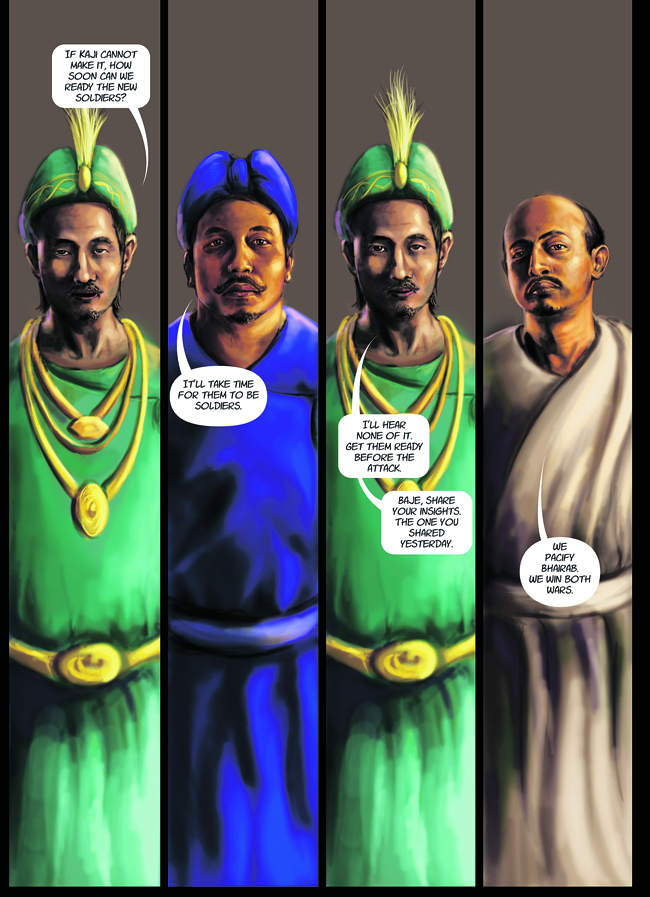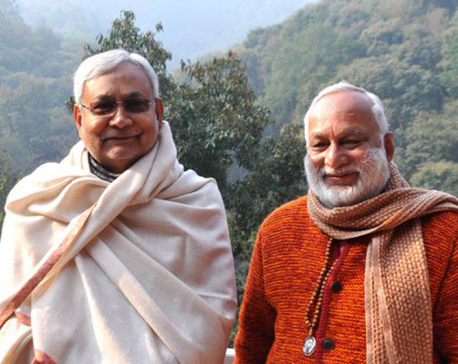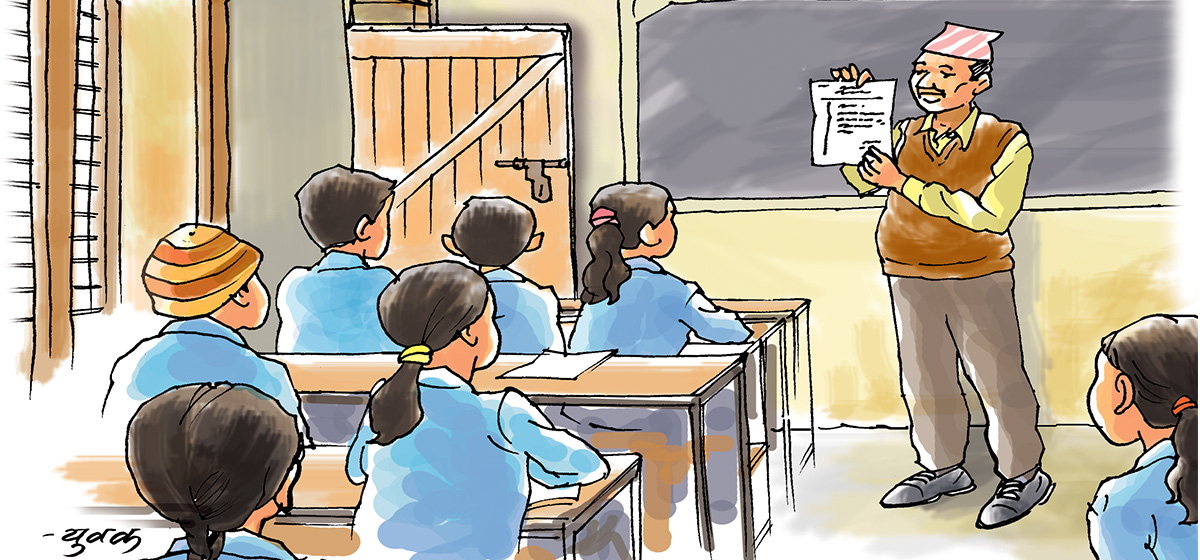
OR

If you love stories, you simply can’t afford to underestimate the story telling prowess of graphic novels. Even though this genre hasn’t quite gained mass popularity in our country yet, there are people putting in the effort and giving it a go with their storyboards and illustrations.
Case in point: Rishi Amatya and Prakash Ranjit, who recently caught The Week’s attention with their latest work. Amatya is the author and Ranjit, the artist of Lumankati. It’s apparently taken them two years to learn and implement the technicalities of putting together a graphic novel but now, they are finally ready to test the waters with their debut release.
Lumankati takes us all the way back to 1254 CE and opens up on an eerily quiet and dark night outside the palace of King Juju Ananda Malla. The graphic novel barely takes about four panels to then hit us with a mystically sinister shadow which leads to agitated guards, flailing swords, momentary chaos and screams from the King’s room itself.
As a reader, you are certainly intrigued and as the story unfolds, as a Nepali reader, it’s a delight to be able to identify with the Nepali legends, myths, and history that’s spilling from its pages. The illustrations are particularly impressive and, for a first effort, the storytelling is decent as well. Here they share their experience of putting it together.
Excerpts:
Why did you pick this particular story?
The earthquake two years ago was another defining moment. Its aftermath unearthed so many incredible historical facts of Nepal. Starting from the very first recorded earthquake in our country back in 1255 CE to today, the instances have been tied with so many superstitions and legends. Since there were no scientific explanations yet, people put it all down to the supernatural. It’s something that can entice readers from across generations and cultures.
As it is, we are both interested in Nepali history and legends. It’s fascinating when you think about it. One can draw many parallels between the modern day superheroes and our demigods and demons. Our legends are interlaced with actual history and our beliefs, myths and superstitions. It was a perfect fit for a graphic novel. (R)
Did you have to do extensive research? How much of it is based on actual facts?
I have been writing and covering historical as well as cultural pieces for a long time now. So as it is, I was already going through journals, books and interviewing cultural experts. We sort of pieced together certain accurate historical facts and built our story from there.
The characters Kaji and Baje are mentioned in our history books as well. It’s also true that during those eras, Kings were more interested in spending their money to appease the Gods and Kumari rather than building their armies and protecting their territories. Our people were incredibly superstitious and there are written accounts of the legends of Kal Bhairav and priests who were highly trained in the mystical arts. This graphic novel develops around all of these amusing notes from our history and culture. (R)
Describe the process of working on a graphic novel?
The way you write stories is very different from how you write comics. As the writer you can not only describe the scene, you have to give details about the environment as well. What time of the day is it? How’s the body language of the characters? Are there any props around? It’s visual writing. Basically you need to see the panels of the novel before the artist sits down to sketch them out.
Once the artists get your notes, his feedback is also very important. It’s the next step and there are still many factors to consider. Panel distribution, text distribution, sequence of the story, the look and feel of the page; it’s a collaborative effort between the artist and the writer. (P)
What about the getting the work published? How did you go about it?
We didn’t approach many publishers. The few that we did reach out to thought it was a good story but were apprehensive since they didn’t have experience with graphic novels or works that targeted young adults. But the thing was we had already decided that if we didn’t get much help and we needed to publish the work ourselves, we would do it. We were determined to get it out there because otherwise we would never know if there was a market for it or not. (P)
So what’s next? Is Lumankati going to be part of a series or are you working on completely new material?
No, it’s not going to be a series. Rather than focusing on continuing the sequence of the story, we would like to bring a series of different stories. We don’t want to fixate on the same character either but the events may link up, and the theme of ancient tales and history may continue. (R)
The thing about graphic novels is that it gives you the luxury to play around with different genres. Be it science fiction, horror, action, fantasy, contemporary, the possibilities are endless. We want to reach out to homegrown writers and artists/ illustrators to see if they would be interested in collaborating with us for future projects as well. (P)
 The title of our graphic novel refers to the earthquakes that have plagued our country. Lumankati, in Newar language, basically means ‘remember it’ or ‘don’t forget’. Historical records show that our country has had major quakes every 80-100 years. So while every other generation has been through the turmoil, there is that other half who completely disregards its danger and consequences. We are merely saying don’t forget it.
The title of our graphic novel refers to the earthquakes that have plagued our country. Lumankati, in Newar language, basically means ‘remember it’ or ‘don’t forget’. Historical records show that our country has had major quakes every 80-100 years. So while every other generation has been through the turmoil, there is that other half who completely disregards its danger and consequences. We are merely saying don’t forget it.
 We deliberated a lot about the kinds of technique that would best suit our visual narrative. There are always many options. We wondered whether we should use pencil sketches, charcoal or simply stick to the incline, flat colors mostly used in comics. But there was a certain vibe and feel that we wanted our graphic novel to exude so eventually we settled on digital painting. We built up our story from scratch on Photoshop. Personally, since I (Prakash) am familiar with the technique, it helped with the speed and was convenient as well. It usually took me a day to finish a page; two days, if there were intricate details to fill in.
We deliberated a lot about the kinds of technique that would best suit our visual narrative. There are always many options. We wondered whether we should use pencil sketches, charcoal or simply stick to the incline, flat colors mostly used in comics. But there was a certain vibe and feel that we wanted our graphic novel to exude so eventually we settled on digital painting. We built up our story from scratch on Photoshop. Personally, since I (Prakash) am familiar with the technique, it helped with the speed and was convenient as well. It usually took me a day to finish a page; two days, if there were intricate details to fill in.
 We carried out extensive research to develop our characters. We used Malla era statues and paintings as references so as to get the look i.e. the costumes and accessories right. Later on, we also brought in our friends and used them as character models. This was for the illustrations. We needed visual references so we sort of cast our friends into roles that we thought best suited them. Then, we had them pose for various scenes so we could base the sketches’ facial features and body language on them. We could have done without all these elaborate preparation but I wanted the illustrations to be a bit different from regular comic style. I think these visual references helped add an extra dimension to our characters.
We carried out extensive research to develop our characters. We used Malla era statues and paintings as references so as to get the look i.e. the costumes and accessories right. Later on, we also brought in our friends and used them as character models. This was for the illustrations. We needed visual references so we sort of cast our friends into roles that we thought best suited them. Then, we had them pose for various scenes so we could base the sketches’ facial features and body language on them. We could have done without all these elaborate preparation but I wanted the illustrations to be a bit different from regular comic style. I think these visual references helped add an extra dimension to our characters.
PS: Just in case you didn’t notice, the King is based on Rishi.
Copies of Lumankati are available for purchase at Jhoche, Basantapur and Red Mud Café branches. They will soon be available on sastobooks as well.
You May Like This

Disney Legends honor prompts Robert Downey Jr. pot story
Robert Downey Jr. says he had a wild Disneyland ride in his younger days. ... Read More...

Legends retold
We all love a good story. Which is probably why we are so fascinated by myths and legends. Our cultures... Read More...

More loathing lore
Any community that submits itself to be excluded from the right to be defended and the duty to bear arms... Read More...







Just In
- Shrestha nominated as Chairman of NCC's Advisory Council
- Take necessary measures to ensure education for all children
- Nepalgunj ICP handed over to Nepal, to come into operation from May 8
- Nepal to gift two elephants to Qatar during Emir's state visit
- NUP Chair Shrestha: Resham Chaudhary, convicted in Tikapur murder case, ineligible for party membership
- Dr Ram Kantha Makaju Shrestha: A visionary leader transforming healthcare in Nepal
- Let us present practical projects, not 'wish list': PM Dahal
- President Paudel requests Emir of Qatar to help secure release of Bipin Joshi held hostage by Hamas



_20240423174443.jpg)







Leave A Comment